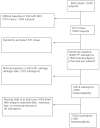Co-localisation of non-cartilaginous articular pathology increases risk of cartilage loss in the tibiofemoral joint--the MOST study
- PMID: 22956600
- PMCID: PMC3871211
- DOI: 10.1136/annrheumdis-2012-201810
Co-localisation of non-cartilaginous articular pathology increases risk of cartilage loss in the tibiofemoral joint--the MOST study
Abstract
Purpose: To assess risk of cartilage loss in the tibiofemoral joint in relation to baseline damage severity, and to analyse the association of nearby pathologic findings on the risk of subsequent cartilage loss.
Methods: The Multicenter Osteoarthritis Study is a longitudinal study of individuals with or at high risk for knee osteoarthritis. MRI examinations were assessed according to the Whole Organ MRI Score. Included were all knees with available baseline and 30 months MRIs. Ordinal logistic regression was used to estimate risk of cartilage loss in each subregion in relation to the number of associated articular features including bone marrow lesions, meniscal damage and extrusion and also in regard to baseline damage severity, respectively.
Results: 13 524 subregions of 1365 knees were included. 3777 (27.9%) subregions exhibited prevalent cartilage damage at baseline and 1119 (8.3%) subregions showed cartilage loss at 30-month follow-up. Risk of cartilage loss was increased for subregions with associated features (OR 2.53, 95% CI 2.03 to 3.15 for one, 4.32 95% CI 3.42 to 5.47 for two and 5.30 95% CI 3.95 to 7.12 for three associated features; p for trend<0.0001). Subregions with prevalent cartilage damage showed increased risk for further cartilage loss compared to subregions with intact cartilage at baseline with small superficial defects exhibiting highest risk.
Conclusions: Risk of cartilage loss is increased for subregions with associated pathology and further increased when more than one type of associated feature is present. In addition, prevalent cartilage damage increases risk for subsequent cartilage loss.
Keywords: Knee Osteoarthritis; Magnetic Resonance Imaging; Osteoarthritis.
Conflict of interest statement
References
-
- Felson DT, McLaughlin S, Goggins J, et al. Bone marrow edema and its relation to progression of knee osteoarthritis. Ann Intern Med. 2003;139:330–6. - PubMed
-
- Englund M, Lohmander LS. Risk factors for symptomatic knee osteoarthritis fifteen to twenty-two years after meniscectomy. Arthritis Rheum. 2004;50:2811–9. - PubMed
-
- Pelletier JP, Martel-Pelletier J, Abramson SB. Osteoarthritis, an inflammatory disease: potential implication for the selection of new therapeutic targets. Arthritis Rheum. 2001;44:1237–47. - PubMed
-
- Peterfy CG, Guermazi A, Zaim S, et al. Whole-Organ Magnetic Resonance Imaging Score (WORMS) of the knee in osteoarthritis. Osteoarthritis Cartilage. 2004;12:177–90. - PubMed
-
- Bijlsma JW, Berenbaum F, Lafeber FPJG. Osteoarthritis: an update with relevance for clinical practice. Lancet. 2011;377:2115–2126. - PubMed


